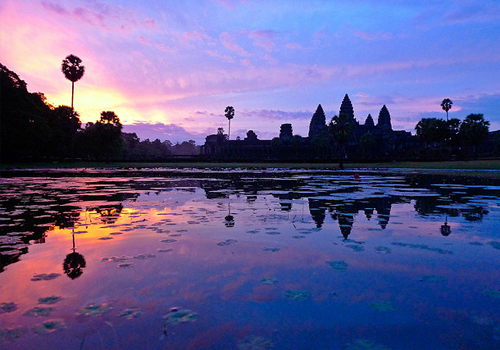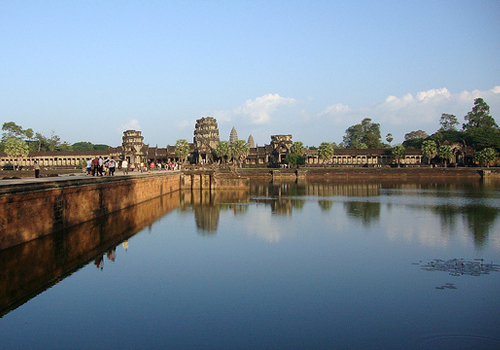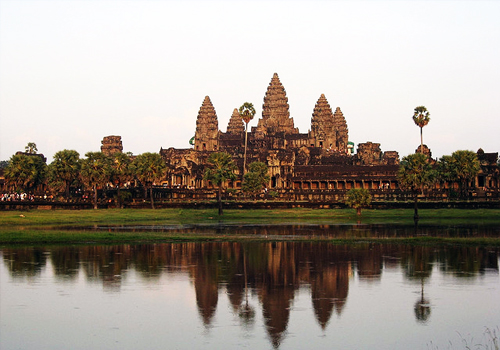Siem Reap Travel Guide
Villages on Stilts
Address: Siem Reap
Most tuk-tuk and moto drivers in Siem Reap will be only too happy to take you on a tour of one of the area's famous 'villages on stilts'. Many of the houses lining Tonle Sap Lake are built on ten foot (3m) poles, so that when the water rises - as it does every year during the monsoon - the homes are not flooded or washed away. The closest floating village is situated in Chong Khneas, just an hour's drive from Siem Reap, though there are a number of these floating villages located around the Tonle Sap Lake should you wish to make a real trip out of it. Villages closer to Siem Reap tend to be touristy, while those further away are far more picturesque and authentic.<br /><br /> A two-hour boat trip through Chong Kneas village costs about $8 per person or around $20 for a boatload. Although during the wet season the stilted homes come into their own from a practical point of view the villages are most visually spectacular during the dry season, when their long stilts rise up eerily out of the mud or shallow water. Be aware that there have been tourist scams in the villages and that the poverty witnessed can be disturbing.<br /><br />
Tonlé Sap Lake
Address: The lake is about nine miles (15km) south of Siem Reap Siem Reap
Boeung Tonlé Sap (Tonlé Sap Lake) is one of the largest freshwater lakes in Asia, and boasts a rich and diverse eco-system. Inhabitants include multiple bird and fish species, crocodiles, turtles, macaques and otters, as well as villagers living in stilted or floating houses. The Prek Toal Bird Sanctuary in the Tonlé Sap Biosphere Reserve is home to ibis, stork, pelicans and fish eagles; the best time to view these birds is in the dry season. There is also a Tonlé Sap Exhibition in Siem Reap, showcasing Khmer heritage through a display of the local people's culture and environment.<br /><br /> Boat tours on the lake are popular and an enthralling way to see the riverside villages and interact with the locals. Be aware, however, that while the majority of guides are friendly and competent there have been reports of some trying to scam tourists and charge ridiculous rates for boat trips. It usually costs well under $20 to hire a boat and you can share it between a few people. Tips for the guides are also expected.<br /><br />
Temples of Angkor
Address: Three miles (5km) outside Siem Reap Siem Reap
The magnificent Temples of Angkor are a must-see on any trip to Cambodia, taking the visitor into the heart of the ancient Khmer Empire. Built between the 9th and 13th centuries, more than 100 temples have been uncovered as evidence of this impressive ancient civilisation and one of the biggest cities of its time. Angkor Wat is the largest religious monument ever built, an impressive Hindu temple surrounded by a moat, and acknowledged as one of the wonders of the world. The walled Royal City of Angkor Thom is home to the Bayon Temple and its huge stone faces, another fascinating attraction. Khmer architecture is unique and although it evolved from that of the Indian subcontinent, and borrowed from neighbouring traditions, Angkor Wat stands as testament to the power and individuality of the Khmer's ancient oriental art form.<br /><br /> The complex includes ancient ruins, well-preserved temples, religious sites, monuments and lots of stone work and will take you a few days to explore in entirety. If your budget allows, you can see Angkor from the air in a hot air balloon or helicopter. It is particularly special to see the temple complex at sunrise and sunset, and it is best to avoid going during the midday heat. Don't forget hats and drinking water and wear comfortable walking shoes. Also note that visitors are expected to dress respectfully and ticket vendors may refuse entry to those showing too much skin.<br /><br />
Aki Ras Landmine Museum
Address: Located four miles (6km) south of Banteay Srey Temple, within the Angkor Wat Archaeological Park Siem Reap
The Aki Ra Museum, often simply called the Cambodian Landmine Museum, provides a jarring counterpoint to the ancient Khmer glories on display at Angkor Wat by showcasing the more recent horrors of Cambodia's political and social upheavals. This museum, founded by Aki Ra, a former Khmer Rouge child soldier, provides a clear and compelling account of this troubled time, and the appalling legacy of landmines and unexploded ordinance that are still a blight on the lives of Cambodian people today. Despite ongoing efforts to find and defuse these sleeping weapons, it is estimated that about five million still remain. Aki Ra himself deactivated over 50,000 of them, many on his own initiative. The museum contains hundreds of these landmines, and many other weapons, and provides a useful service by teaching visitors and locals how to recognise these devices and what to do should they encounter them. The museum exists primarily to tell Aki Ra's fascinating story, and to gain exposure for the Cambodian struggle with landmines, but it is also home to a number of children supported by the museum, who are all victims either of landmines, disease or simply poverty.<br /><br />
Psar Chaa - Old Market
Address: Siem Reap
Psar Chaa, the Old Market, is Siem Reap's most popular shopping experience for visitors. The outside stalls sell souvenirs such as silk, carvings, stoneware, faux vintage items, clothes, paintings and photos of Angkor Wat temples. You can even get very reasonably priced haircuts at the market. Further inside are fresh produce and seafood stalls. The food stalls are an excellent opportunity to sample authentic Khmer food, invariably served with the distinctive local prahok, a type of fermented fish paste. A good accompaniment is coconut milk drunk directly from the fruit. The ubiquity of baguettes and frog legs is a clear, and delicious legacy of the French colonial era.<br /><br /> Be aware that some merchants have learnt to exploit naive tourists; you are expected to bargain and can get up to 75 percent off the asking price if you do so well. Be patient and good-natured and maintain your sense of humour and you can get wonderful deals. The Old Market is very central and conveniently located close to the river and the popular Pub Street.<br /><br />
Beng Mealea
Address: 45 miles (70km) from Siem Reap Siem Reap
For those visitors especially charmed by Tah Prom's jungle-clad stones within the Angkor Wat complex, it is well worth making the five-hour round trip to visit Beng Mealea, a little-visited sandstone temple, now fused with the surrounding jungle. Built in the 12th century as a Hindu temple, and long since abandoned, this sprawling complex is on a similar scale, and built in a very similar style, to Angkor Wat, and closely approximates what the first western visitors there must have experienced when stumbling upon these forgotten wonders.<br /><br /> Little is known about the temple's history but it was probably once the centre of a town long ago overtaken by the dense Cambodian jungle. If you prefer to travel off the beaten track then Beng Mealea, overgrown and largely unrestored, will captivate you with its mystery and the relative freedom of the experience of exploring it. You are allowed to climb and investigate and the peaceful atmosphere encourages many visitors to spend time reading, writing or relaxing in a chosen spot among the ruins. Many of the carvings have been desecrated by earlier souvenir hunters, but in other ways the integrity and atmosphere of the structure has benefitted from the small number of visitors.<br /><br />
Angkor National Museum
Address: No.968, Vithei Charles de Gaulle, Phoum Salakanseng, Khom Svaydangum, Siem Reap Siem Reap
This museum is a convenient and useful stop-over en route to the temples of Angkor. It allows visitors to gain some insight into the centuries of history, culture, rich symbolism, and myth associated with the temple complex which often remains hidden when viewing the Angkor temples without a guide. The museum's main attractions are its archaeological treasures, including the lion and demon heads missing from the temple statues, Khmer artefacts predating the Angkor period, and a fascinating collection of ancient Khmer and Sanskrit inscriptions on stone tablets. There is a striking gallery dedicated solely to images of Buddha and a gallery featuring the ancient costume of the Angkor period, including jewellery and headdresses.<br /><br /> The museum uses multimedia displays and various artefacts to evoke the golden age of Khmer culture and to give insight into its history. Displays are colourful and vibrant and the information is informative and accessible. The building itself is quite new (opened in 2007) and is ultra-modern, lavishly air-conditioned, and enormous, with over 20,000 square metres of floor space and some dramatic fountains. There is also a museum gift shop for souvenirs. Allow at least an hour for a visit. In addition to the entrance fee, and the optional extra cost for taking in a camera, visitors can pay for an educational headset.<br /><br />
Chaul Chnam Thmey
Where: Angkor Wat,Siem Reap
When: 13 April 2018
A Cambodian event not to be missed is the Chaul Chnam Thmey (Khmer New Year), a three day festival held in April each year featuring colourful processions, music, dancing... and a lot of water and talcum powder bombs! People douse each other with water as a blessing, with coloured water signifying the wish for a colourful future. The local Khmer people make offerings and exchange gifts. Traditionally, houses are cleaned and decorated with flowers, streamers and balloons and an altar is set up to welcome the spirit of new year. People wear new clothes for the celebrations and children give gifts of money, fruit, or other foods to their elders as a sign of respect. Many children also wash the feet of their parents or other elders to show their devotion and respect. Cambodians have many traditional games and these are played enthusiastically over the Cambodian New Year on street corners and in homes.<br /><br /> Chaul Chnam Thmey marks the beginning of the new year but also the end of the busy harvesting season, when farmers give thanks and celebrate the fruits of their labour. It is a fun and exhilarating time to visit the country, particularly the Angkor Wat Temple complex, where celebrations reach their peak.<br /><br />
Angkor Wat International Half Marathon
Where: ,Siem Reap
When: 3 December 2017
The Angkor International Half Marathon now attracts more than 5,000 runners annually, with nearly 50 countries represented in recent years. First held in 1996 this 21km race through, in, and around the magnificent Angkor temples is becoming increasingly popular. The setting alone makes it an iconic addition to the international race calendar, with the evocative temples a constant backdrop to the athlete's efforts. The race starts before dawn in order to avoid the stifling heat and humidity of the day. All funds raised are devoted to victims of landmine explosions and a number of other pressing issues in Cambodia including the treatment of HIV Aids. There is also an Angkor bike race which has three categories: the 100km race, the 30km race and a fun family race event. The bike race is usually held the day before the marathon. Participants can also choose to attend a number of related celebrations and events including a Gala Dinner Party at the Prasat Bei Temple which includes a traditional dance show. As one can imagine, the Angkor International Half Marathon is a wonderful sports event for spectators.<br /><br />
(Data provided outside US and Canada by Foreca, Data provided for US and Canada by WDT)
| Jan | Feb | Mar | Apr | May | Jun | Jul | Aug | Sep | Oct | Nov | Dec | |
| Average High | 31° | 32° | 33° | 35° | 33° | 32° | 32° | 32° | 31° | 30° | 30° | 30° |
| Average Low | 21° | 22° | 23° | 24° | 24° | 24° | 24° | 24° | 24° | 24° | 23° | 21° |
(Data provided outside US and Canada by Foreca, Data provided for US and Canada by WDT)
| Jan | Feb | Mar | Apr | May | Jun | Jul | Aug | Sep | Oct | Nov | Dec | |
| Average High | 88° | 91° | 93° | 95° | 93° | 91° | 90° | 90° | 88° | 87° | 86° | 86° |
| Average Low | 71° | 72° | 74° | 76° | 76° | 76° | 76° | 76° | 76° | 76° | 74° | 71° |


